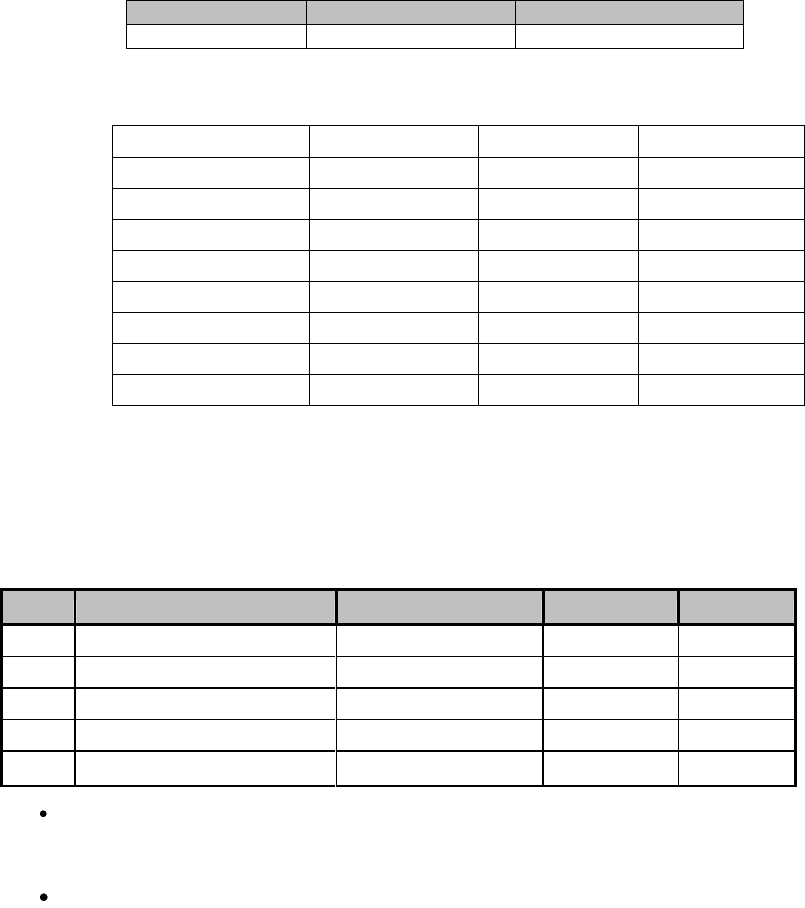Laird Connectivity RM024 2.4GHZ FREQUENCY HOPPING SPREAD SPECTRUM TRANSCEIVER SYSTEM User Manual 1
AeroComm Corporation 2.4GHZ FREQUENCY HOPPING SPREAD SPECTRUM TRANSCEIVER SYSTEM 1
Contents
- 1. USERS MANUAL
- 2. User Manual
USERS MANUAL

RM024 Compliance Section
RM024 FCC / IC Information
Agency Identification Numbers
Family
US/FCC
CANADA/IC
RM024
KQL-RM024
2268C-RM024
RM024 FAMILY
*PART #
FORM FACTOR
TX OUTPUT
ANTENNA
RM024-S125-C-XX
Surface Mount
125mW
U.FL
RM024-S125-M-XX
Surface Mount
125mW
U.FL or chip
RM024-P125-C-XX
Pluggable
125mW
U.FL
RM024-P125-M-XX
Pluggable
125mW
U.FL or chip
RM024-S50-C-XX
Surface Mount
50mW
U.FL
RM024-S50-M-XX
Surface Mount
50mW
U.FL or chip
RM024-P50-C-XX
Pluggable
50mW
U.FL
RM024-P50-M-XX
Pluggable
50mW
U.FL or chip
*Last two slots "XX" in Part # are used for custom setups. Can be values 01-99
Antenna Information
RM024 family has been designed to operate with the antennas listed below and having a maximum
gain of 9dBi. The required antenna impedance is 50 ohms.
Item
Part Number
Mfg.
Type
Gain (dBi)
1
WIC2450-A
Laird Technologies
Chip
2
2
NZH2400-MMCX
Laird Technologies
Microstrip
1
3
ID2450-RS36
Laird Technologies
Panel
9
3
IG2450-RS36
Laird Technologies
Omni
6
4
S151FC-L-(132)PX-2450S
Nearson
Dipole
5
The OEM is free to choose another vendor’s antenna of like type and equal or lesser gain as
an antenna appearing in the table and still maintain compliance. Refer ence FCC Part
15.204(c)(4) for further information on this topic.
To reduce potential radio interference to other users, the antenna type and gain should be
chosen so that the equivalent isotropically radiated power (e.i.r.p.) is not more than that
permitted for successful communication.

POWER EXPOSURE INFORMATION
In general, there are two agency classifications for RF radiation exposure in wireless applications;
portable and mobile.
Mobile – A mobile device is defined as a transmitting device designed to be used in such a way that a
separation distance of at least 20 centimeters is normally maintained between the transmitter's
radiating structures and the body of the user or nearby persons. The RM024 is fully modular approved
for mobile and fixed applications. Reference FCC Part 2.1091 for further details on mobile devices.
Portable – Portable is a classification of equipment where the user, in general, will be within 20 cm of
the transmitting antenna. Portable equipment is further broken down into two classes; within 2.5 cm of
human contact and beyond 2.5 cm. The RM024 does not hold a portable approval classification due to
its peak output power and modular approval restrictions. Further RF evaluation is required by
customers who want to use the RM024 in portable applications. Contact a qualified test house or a
Laird Technologies representative for further information on this topic. Reference FCC Part 2.1093 for
further details on portable devices.
Maximum Permissible Exposure report has been created which shows the minimum distances for
Public and Occupational use of the RM024.
Occupational Limit Minimum Distance = 4cm
Public Limit Minimum Distance = 9cm
Full MPE report available upon request
OEM RESPONSIBILITIES
WARNING: The OEM must ensure that FCC labeling requirements are met. This includes a clearly visible
label on the outside of the OEM enclosure specifying the appropriate Laird Technology FCC identifier for this
product as well as the FCC notice below.
Contains FCC ID: KQL-RM024
This enclosed device complies with Part 15 of the FCC Rules, Operation is subject to the following two
conditions: (1) This device may not cause harmful interference, and (2) This device must accept any
interference received, including interference that may cause undesired operation
Label and text information should be in a size of type large enough to be readily legible, consistent with
the dimensions of the equipment and the label. However, the type size for the text is not required to be
larger than eight point.
CAUTION: The OEM should have their device which incorporates the RM024 tested by a qualified test
house to verify compliance with FCC Part 15 Subpart B limits for unintentional radiators.
WARNING: This device has been tested with an U.FL connector and the antennas listed in the table
above. When integrated into the OEM’s product, these fixed antennas require professional installation
preventing end-users from replacing them with non-approved antennas. Any antenna not listed in the
above table must be evaluated for compliance with FCC Part 15.203 for unique antenna connectors.
Contact Laird Technology for assistance.

WARNING: This equipment has been approved for mobile applications where the equipment should
be used at distances greater than 20 cm from the human body. Operation at distances of less than 20
cm requires additional RF exposure evaluation and possible testing, including SAR requirement
according to FCC RF Exposure guideline.
CAUTION: Any changes or modifications not expressly approved by Laird Technology could void the
user’s authority to operate the equipment.
NOTE: This equipment has been tested and found to comply with the limits for a Class B digital device,
pursuant to Part 15 of the FCC Rules. These limits are designed to provide reasonable protection
against harmful interference in a residential installation. This equipment generates, uses, and can
radiate radio frequency energy and, if not installed and used in accordance with the instructions, may
cause harmful interference to radio communications. However, there is no guarantee that interference
will not occur in a particular installation. If this equipment does not cause harmful interference to radio
or television reception, which can be determined by turning the equipment off and on, the user is
encouraged to correct the interference by one or more of the following measures:
Re-orient or relocate the receiving antenna
Increase the separation between the equipment and the receiver
Connect the equipment to an outlet on a circuit that is different from that to which the
receiver is connected.
Consult the dealer or an experienced radio/TV technician for help.